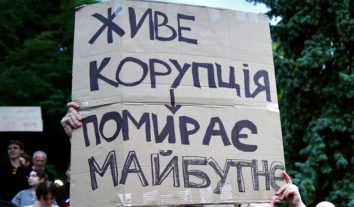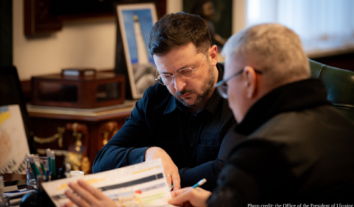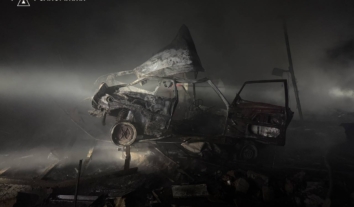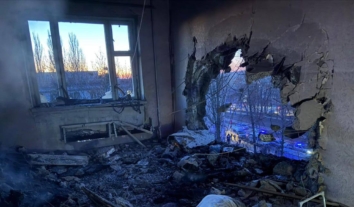‘Women are not beaten here in Ukraine, but our hands are free’: How Russians held women in seized TDC in Kherson
On March 9, 2022, the Russians seized the premises of a temporary detention center (TDC) in Kherson. They set up a prison with a torture chamber for local civilians there.
At first, the Russians allocated two cells, and later a third, specifically for women. At different times, at least 30 local women were held there, including a policewoman, a housewife, a cadet of a military educational institution, and a head teacher of a gymnasium.
Women were beaten and tortured, including with water and electric shocks. However, the Russians mostly used psychological violence against them – regular threats, including with rape, intimidation, and abuse of other prisoners in neighboring cells or the corridor.
Before the de-occupation of Kherson, the Russian military transported part of the TDC detainees to the occupied left bank of the region. In particular, four women were relocated. All of them have been already released from illegal places of detention. The last two women were released in May 2023.
This is described in the analytical report “”Women’s cells” of Kherson torture chamber” which was prepared by Human Rights Centre ZMINA specialists based on testimonies of victims.
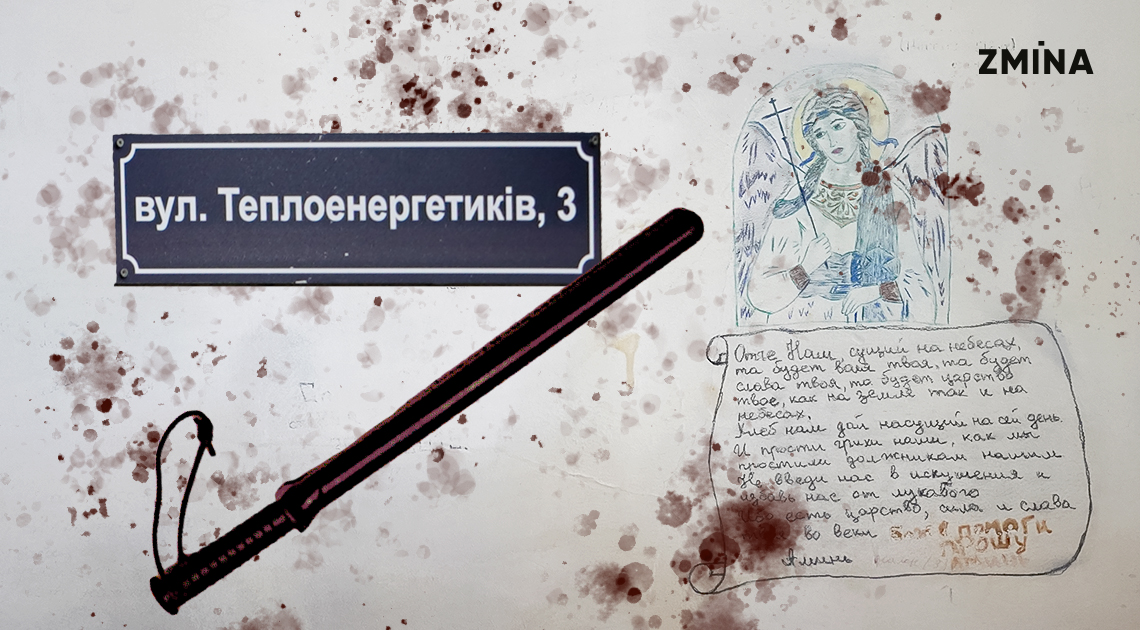
Arbitrary detention and torture are one of the main methods used by the Russians to suppress any resistance in the occupied territories.
Thus, after part of Kherson region was liberated, Ukrainian law enforcement officers discovered 11 torture chambers and 13 places of detention where the Russian military and special agents held and abused the civilians of Kherson city and region. Investigators check information regarding the confinement of almost 1,000 people there. More than 200 of them were prisoners of the seized temporary detention center in Kherson, the report says.
As part of the investigation on TDC, Ukrainian law enforcement officers interviewed and recognized 21 women as victims. At the same time, the documentators of Human Rights Centre ZMINA established that the Russians held at least 30 women in the detention center at different times.
“It was like they were detaining two terrorists”
The Russians detained some of the victims in a planned manner: they knew names, addresses, and other personal data of the women. For the most part, this concerned female law enforcement officers, as well as those whom the Russian military could suspect of having links with Ukrainian forces and the resistance movement in the occupied territories.
Thus, Russian special services purposefully searched for and then detained a policewoman from Kherson and a cadet of the Ivan Kozhedub Kharkiv National Air Force University.
There were also cases when women were used as hostages to detain their relatives or acquaintances. In particular, the Russian forces had held Chornobayivka resident Olha Strohan until they took away her husband.
Documentators also recorded cases when Russians broke into private houses and decided on the spot whom they would take prisoner:
“One was joking, saying: “What do we have for a little one? Let’s take the little one” That is, my son. Then they wanted to take my husband. Then they decided to take only me,” said one of the interviewed victims.
Women were usually detained at home late in the evening or in the middle of the night, human rights activists say. They were visited by large groups of armed Russians who, in addition, also searched the houses of the victims.
“It seems that both the time of the searches and the number of participants in the detention were intended to exert additional pressure and intimidate the detainees,” the report reads.
Russian forces also used other methods of psychological violence: in particular, they pointed weapons at women, asked who Putin was, to which they had to answer: “Our president!”
In another case, the Russians, who came to Iryna Radetska, head teacher of Kherson gymnasium, threatened to start shooting at neighboring apartments if the woman did not open the door.
During searches and detentions, the Russian military used physical force. The Russians hit one of the interviewed women on the back of her head several times so severely that an earring flew off her ear.
Another victim said that Russian soldiers beat her 16-year-old son in the face and demanded that he cut his long hair.
The Russian military and special agents conducting searches took away people’s documents, personal phones, and laptops. Some of the interviewees noted that after the search, valuable things disappeared from their homes: bank cards, e-book reader. One detained woman had her car taken away by the Russians.
The Russians did not show any of the interviewed women any documents about the grounds for the search or subsequent detention. Others were presented with formal reasons, such as document checks. During detention, only one of the victims was informed by the Russians that a criminal case had been opened against her.
Human Rights Centre ZMINA experts emphasize that any detention can only take place based on legal grounds and according to a certain procedure.
 Premises of the Kherson TDC Photo: ZMINA
Premises of the Kherson TDC Photo: ZMINA“They don’t really trust polygraph, they trust torture”
At least five women were tortured by the Russians while being held in Kherson TDC, human rights defenders note.
Although beatings and other abuse occurred mainly during interrogations, some women were also beaten by the Russians during detention. One detainee was brought to the TDC with a hemorrhage under her eye and hematomas on her head. According to other victims, the woman was beaten in a car on the way to the detention center.
Detained women were beaten with hands and feet in the stomach, kidneys, legs, and head. Rubber batons could also be used to inflict blows.
The Russians beat one of the victims on the heels with a club, after which she could not stand on her feet for some time.
Russians often combined beatings with other types of torture, such as electric shocks. In particular, the occupiers tortured one of the women with electric shocks on her chest.
Along with this, the Russian military also used water torture: water was poured into the mouths of three interviewed women directly and through a cloth.
“They put on handcuffs, put my hands behind my back, put me on the floor. One held my legs, the second held my mouth, the third poured water, and the fourth, as it seemed to me, was filming everything on the phone. Then they stopped, told me to “go and think” because they would come later,” one of the victims recalls.
Even when women were not beaten, they were regularly threatened with possible torture. For example, during interrogations, Russian law enforcement officers laid batons, stun guns on the table, and ropes were tied to the chairs. They did not use these tools but left them so that the victims could see them.
Most often, the Russians subjected detained women to psychological abuse.
In particular, Russians threatened one of the victims with gang rape and sexual exploitation. They said that she “will work off”, “will be a good woman”, “will serve the soldiers”. Then the Russian military began threatening to rape her underage daughter.
Onysiia Syniuk, a legal analyst at Human Rights Center ZMINA, noted during the presentation of the report that such actions are part of the culture of behavior of the Russian military.
“Such threats were voiced both in the presence of other detainees and in the presence of other military personnel of the Russian Federation. In other words, this is not the kind of behavior for which they could later face disciplinary punishment,” the lawyer added.
In addition, women in TDC were forced to constantly hear and sometimes see abuse against other detainees.
Sometimes the Russians purposefully placed their acquaintances or relatives in the cells next to the women.
“She [one of the detainees] constantly tried to recognize her husband’s voice among the screams. But try to guess. Have you ever heard your husband scream in pain?” recalls one of the victims who was held in that cell.
Another woman recognized the voice of her groupmate behind the wall when he was being tortured.
The victims were mostly not told how long they would be held and for what reason. Relatives were also not informed of their whereabouts. Even when the Russians took packages for detainees brought by their relatives, they did not confirm that a person was in that particular place.
In most cases, families learned about their captive relatives from those already released.
The women, like other detainees, were also not informed when they would be interrogated. In particular, one of the interviewees was told that the interrogation would take place in two days, and it took place in almost a week. Another victim was interrogated only on the 12th day of her stay in the TDC. At the same time, some women were interrogated several times in two days.
In addition, the conditions of their confinement testify to the ill-treatment of captive women.
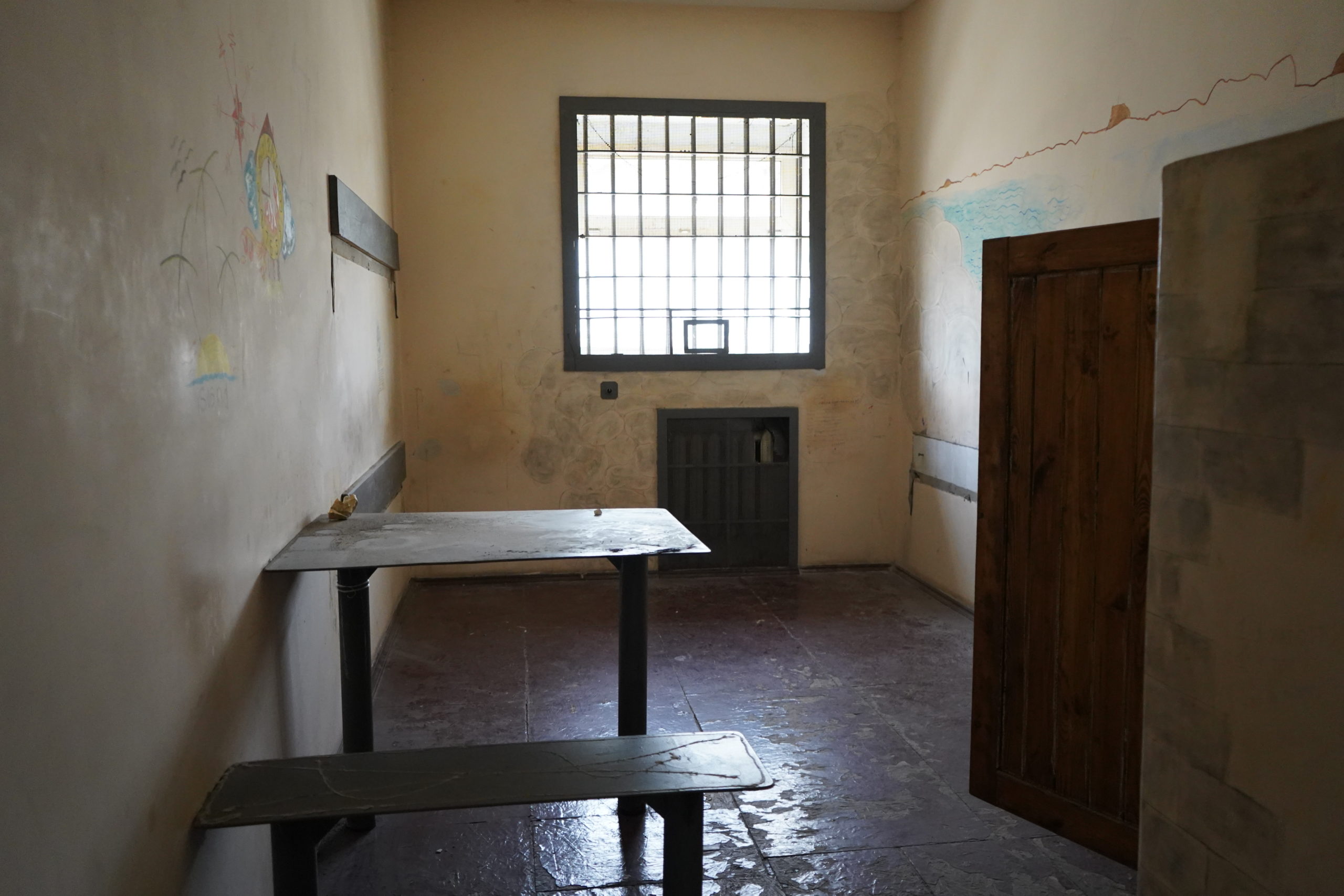 One of the cells of the Kherson TDC where women were held. Photo: ZMINA
One of the cells of the Kherson TDC where women were held. Photo: ZMINAWomen were placed in two-person and three-person cells. However, from five to nine people were held in them at the same time, so women had to sleep on the floor.
“Recently, I took part in an investigative experiment,” said one of the victims during the presentation of the report, “When I entered that cell, I could not imagine how we all lived there because there was not enough space for two people.”
At first, the detainees were not taken to the shower. Some cells had running water from the faucet, so prisoners could wash or rinse things. However, for the most part, women were able to wash themselves only in the shower where they were taken irregularly.
At first, the detainees were not given the opportunity to wash at all. Later, they were taken to the shower and given five minutes each. However, such opportunities were not permanent either – everything depended on the mood and wishes of the senior warden in the TDC – Andrey “Zloy”.
Meals were also irregular in the TDC. According to those interviewed, until August 13, 2022, the detainees were fed only once a day – with pasta and canned food. Sometimes in the evening, they got biscuits and tea, and in the afternoon – “boiling water” – hot or warm water.
In August of last year, meals at the TDC were given three times a day. Food for the whole day was brought to the detention center every morning, and it often happened that in the evening the detainees were given already sour food.
Women were held in cells almost all the time. Later, they began to be taken out to the yard of the detention center from time to time, but there was neither a schedule nor a system for such walks. So, according to one of the interviewees, once they were left in the yard in the rain for three hours.
“We were not very happy with walks because it was another torture,” a victim notes.
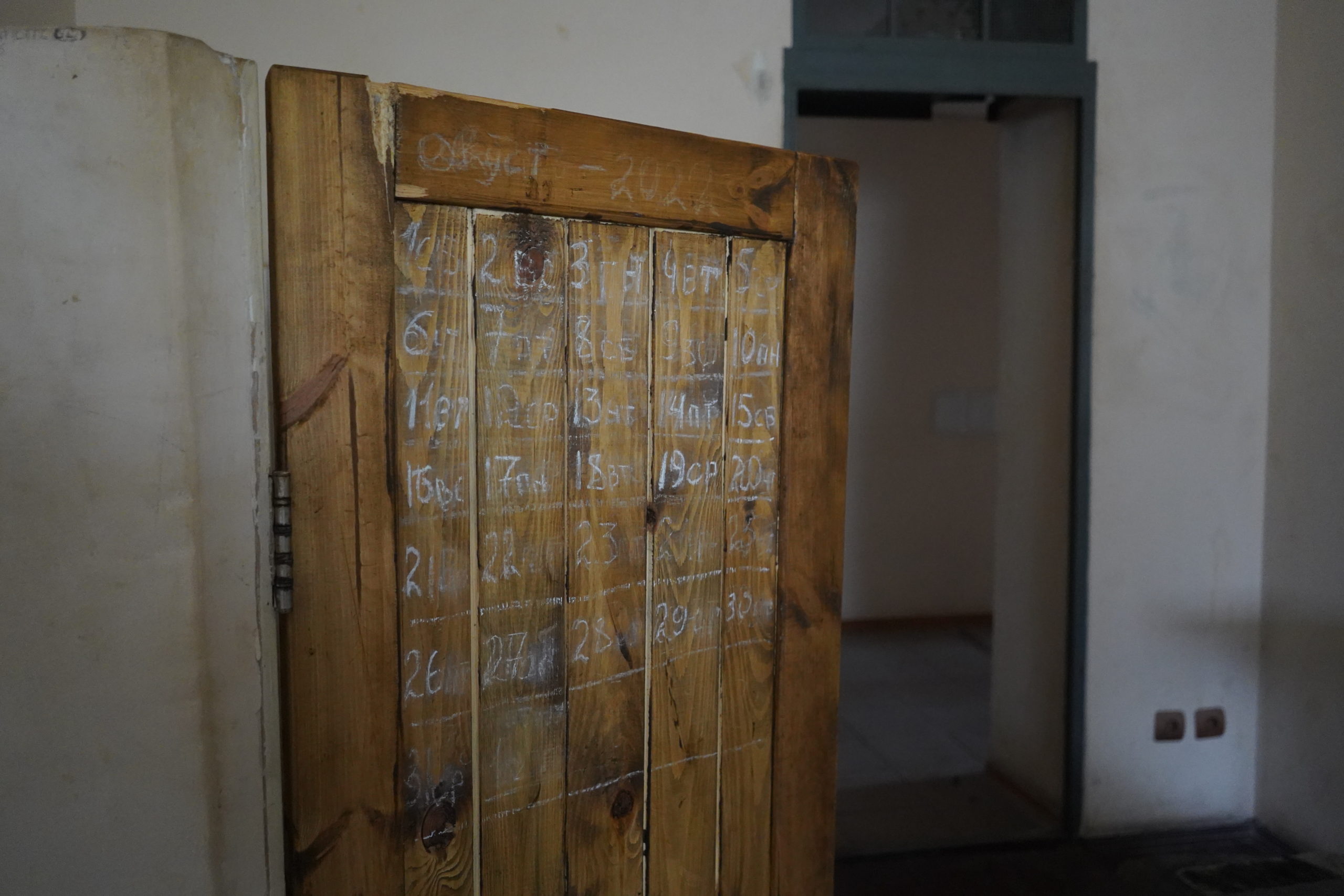 Improvised calendar in one of the TDC cells Photo: ZMINA
Improvised calendar in one of the TDC cells Photo: ZMINAWho is involved in crimes in Kherson TDC
Based on the results of interviews with victims, human rights defenders established that women were detained and imprisoned by Russian security forces from various structures: military, police, and FSB employees.
The former captives also said that from the beginning the prisoners in the TDC were watched over by the Russian Guard. All of them were mostly under 25 years of age and wore military camouflage uniforms, but they also had blue trousers with red stripes like Russian police officers.
At the end of July, according to those interviewed, a rotation took place among TDC wardens. At that time, about 14 men aged 35-30 wearing various uniforms arrived at the detention center.
It was then that the TDC introduced three meals a day, began taking prisoners out for walks and showers, and also established a system of collective punishments. Judging by this, the women assume that they were employees of the Federal Penitentiary Service. In addition, the victims heard how the new wardens talked among themselves about the Russian penal facilities where they worked.
Thanks to the testimonies of the victims, human rights defenders managed to identify individual Russian security agents who detained women and watched over prisoners in the TDC.
In particular, according to the interviewees, the senior warden in the detention center was Captain Andrey Sergeyevich with the call sign “Zloy” – a tall man with brown eyes and dark hair. He appears to be about 40 years old, has a wife and a young daughter, the victims said.
He was the one who gave orders regarding meals, walks, and showers. He also took part in the torture of detainees, in particular, he used a stun gun and beat detainees with a machine gun. In addition, the security officer regularly organized “parades” in the corridors of the TDC: he forced men to march and sing Russian songs.
Human rights defenders note: everything that the Russians did in the TDC with Ukrainian civilians is unlawful. Such actions violate the Geneva Conventions and can also be classified as war crimes under the Rome Statute.
At the same time, the report authors pointed to the ubiquity of cases of torture used by the Russians against the civilian population in Ukraine. They made this conclusion based on testimonies collected by ZMINA documentators in Kharkiv, Kyiv, and Kherson regions, as well as reports of international institutions, such as the UN Independent International Commission of Inquiry.
The experts noted that the collected materials gave reason to believe that the actions of the representatives of the Russian Federation were both large-scale and systematic, having signs of a crime against humanity.
As a reminder, at the beginning of July 2023, the Prosecutor General’s Office sent an indictment against four Russian servicemen to the court. In particular, the investigation established that one of the organizers of the torture chamber in the TDC was police Colonel Aleksandr Naumenko. Together with him, Ukrainian law enforcement officers accuse three more Russian security officers of unlawfully detaining and torturing local residents.



